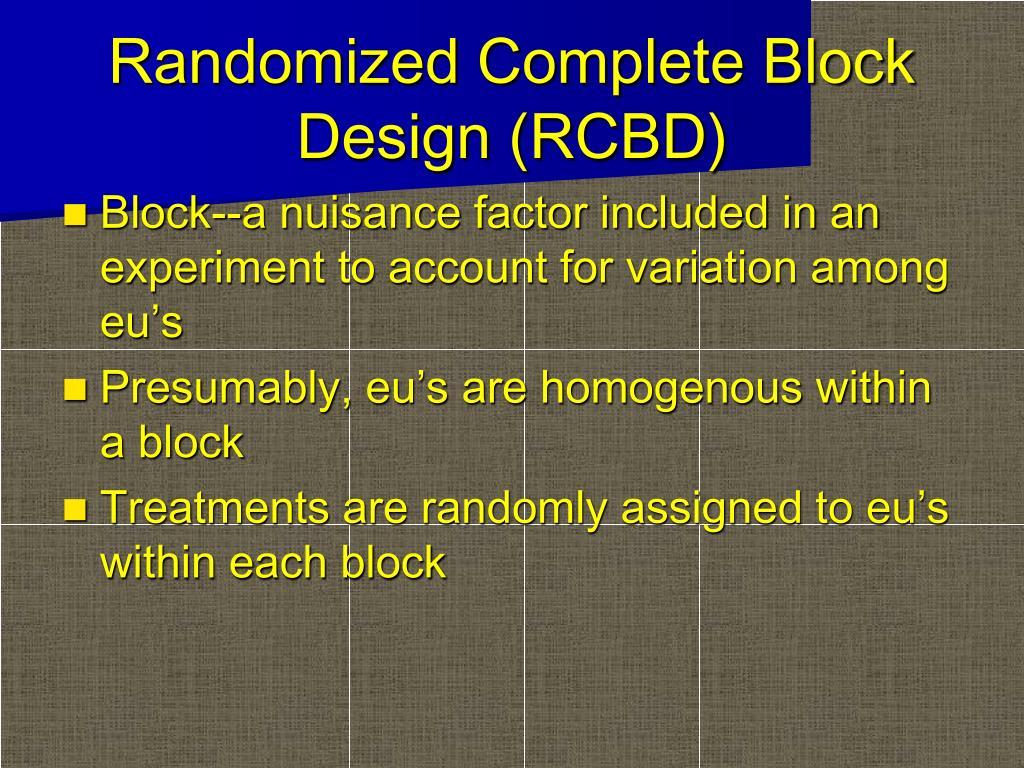Table Of Content
In practice, it is notalways possible or preferable to have thesame number of subjects in all groups of the treatment variable(s).18,19 The block randomization procedure with groups of different sizesis only slightly different. As before, first, blocks of samples whereeach group is proportionally represented are created. For example,if one group is twice as large as the other group, each block wouldconsist of three subjects, one of the smaller group and two of thelarger group (Figure Figure33A).
6 Balanced incomplete block designs
The randomization scheme is then exactly as before, exceptthat half of the randomized blocks are now assigned to BatchA, and the other half to Batch B. In an orthogonal design, such as a RCBD, all information about the treatment comparisons is contained in comparisons made within blocks. For more complex blocking structures, such as incomplete block designs, this is not the case. If the number of times treatments occur together within a block is equal across the design for all pairs of treatments then we call this a balanced incomplete block design (BIBD). In general, we are faced with a situation where the number of treatments is specified, and the block size, or number of experimental units per block (k) is given.
The best experimental designs of 2022 - Fast Company
The best experimental designs of 2022.
Posted: Thu, 15 Sep 2022 07:00:00 GMT [source]
Want to Pass Your Six Sigma Exam the First Time through?

In this experiment, each specimen is called a “block”; thus, we have designed a more homogenous set of experimental units on which to test the tips. The next thing you need to do after you determine your blocking factors is allocate your observations into blocks. To simplify things, we will assume that you have one main blocking factor that you want to balance over. A non-blocked way to run this experiment would be to run each of the twelve experimental wafers, in random order, one per furnace run. That would increase the experimental error of each resistivity measurement by the run-to-run furnace variability and make it more difficult to study the effects of the different dosages. The blocked way to run this experiment, assuming you can convince manufacturing to let you put four experimental wafers in a furnace run, would be to put four wafers with different dosages in each of three furnace runs.
Other Aspects of the RCBD

The latin square design removes both between-litter and between-cage variation from the drug comparisons. For three drugs, this design requires three litters of three mice each, and three cages. Crossing litters and cages results in one mouse per litter in each cage. The drugs are then randomized on the intersection of litters and cages (i.e., on mice) such that each drug occurs once in each cage and once in each litter. Contrasts are defined exactly as for our previous designs, but their estimation is based only on the intra-block information if the estimated marginal means are calculated from the ANOVA model. Estimates and confidence intervals then differ between ANOVA and linear mixed model results, and the latter should be preferred.
3.2 Defining a Balanced Incomplete Block Design
Blackboxes (left) indicate Placebo, red boxes (right)indicate Treatment. The “true abundance”is what would have been measured without the machine drift (Figure Figure11, second row). The“ordered allocation”, “complete randomization”,and “block randomization” is as depicted in Figure Figure11D, H, and L, respectively. Interpretation of the coefficients of the corresponding models, residualanalysis, etc. is done “as usual.” The only difference is that we do not test theblock factor for statistical significance, but for efficiency.
Up is Down: Mid-Century Experiments in Advertising and Film at the Goldsholl Studio - E-Flux
Up is Down: Mid-Century Experiments in Advertising and Film at the Goldsholl Studio.
Posted: Tue, 14 Mar 2023 09:20:16 GMT [source]
We consider this case later, but it does not change the test for a treatment effect. Another way to think about this is that a complete replicate of the basic experiment is conducted in each block. In this case, a block represents an experimental-wide restriction on randomization. Often in medical studies, the blocking factor used is the type of institution. This provides a very useful blocking factor, hopefully removing institutionally related factors such as size of the institution, types of populations served, hospitals versus clinics, etc., that would influence the overall results of the experiment. The final step in the blocking process is allocating your observations into different treatment groups.
Chapter 7 Improving Precision and Power: Blocked Designs
However, this method of constructing a BIBD using all possible combinations, does not always work as we now demonstrate. If the number of combinations is too large then you need to find a subset - - not always easy to do. As an example, let's take any 3 columns from a 4 × 4 Latin Square design. If you look at how we have coded data here, we have another column called residual treatment.
Summary
The same logic applies to keeping columns and replicating rows, of course. The two experiments in Figure 7.14B illustrate this design for a two-fold replication of the \(3\times 3\) latin square, where we use six litters instead of three, but keep using the same three cages in both replicates. In the top part of the panel, we do not impose any new restrictions on the allocation of drugs and only require that each drug occurs the same number of times in each cage, and that each drug is used with each litter. In particular, the first three columns do not form a latin square in themselves. This design is called a , and its experiment structure is shown in Figure 7.15A with model specification y ~ drug + Error(cage+litter) or y ~ drug + (1|cage)+(1|litter). The use of blocking in experimental design has an evolving history that spans multiple disciplines.
A block is characterized by a set of homogeneous plots or a set of similar experimental units. In agriculture a typical block is a set of contiguous plots of land under the assumption that fertility, moisture, weather, will all be similar, and thus the plots are homogeneous. The first step of implementing blocking is deciding what variables you need to balance across your treatment groups. We should keep in mind that variance components are harder to estimate than averages, and estimates based on low replication are imprecise. This is not a problem if our goal is removal of variation from treatment contrasts, but sufficient replication is necessary if estimation of variance components is a primary goal of the experiment. Sample size determination for variance component estimation is covered in more specialized texts.
However, as for allmethods, implementing block randomization can quickly become challengingin real-world situations. In this section, special considerationsare introduced for situations where the reality of the experimentposes challenges in experimental design. Examples of block randomization.(A) 16 subjects receiving placebo(black, subjects 1–16) and eight treatment (red, subjects 17–24),results in eight blocks of three subjects, each containing two Placebo and one Treatment. Theblock containing three subjects is randomly placed among the otherblocks. Subjects are randomly assigned to a block and the order ofthe subjects within each block is randomized.
Ok, with this scenario in mind, let's consider three cases that are relevant and each case requires a different model to analyze. The cases are determined by whether or not the blocking factors are the same or different across the replicated squares. The treatments are going to be the same but the question is whether the levels of the blocking factors remain the same.
This effectively removes the variation captured by the blocking factor from any treatment comparisons. If experimental units are more similar within the same group than between groups, then this strategy can lead to substantial increase in precision and power, without increasing the sample size. The price we pay is slightly larger organizational effort to create the groups, randomize the treatments independently within each group, and to keep track of which experimental unit belongs to which group for the subsequent analysis. It is straightforward to extend an RCBD from a single treatment factor to factorial treatment structures by crossing the entire treatment structure with the blocking factor. Each block then contains one full replicate of the factorial design, and the required block size rapidly increases with the number of factors and factor levels. In practice, only smaller factorials can be blocked by this method since heterogeneity between experimental units often increases with block size, diminishing the advantages of blocking.

No comments:
Post a Comment